 More... More...
|
Eastern American Toad
Anaxyrus americanus americanus
Up to 4.25 inches (107 mm)
Dry warty skin and short legs. Each dark spot on its back contains 1 or 2 warts. Spotted chest and belly. Paratoid gland behind their head usually doesn't touch or barely touches the crest/ridge behind eye. Occasionally has a light dorsal stripe. Males smaller than females
and may have dark throats.
2,000-20,000 eggs are laid in a pair of long jelly-like strings with partitions between each egg keeping them separate. Tadpoles very dark and may school together. Metamorphose in 6-10 weeks. May occasionally hybridize with Fowler's Toad. |
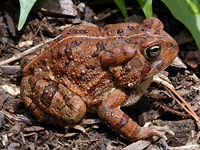 More... More...
|
Fowler's Toad
Anaxyrus fowleri (Formerly Bufo)
Up to 3.25 inches (82 mm).
Dry, warty skin and short legs. Each dark spot on its back contains 3 or more warts. Chest and belly white except for maybe one spot. Paratoid gland behind their head touches crest/ridge behind eye. Usually has a light dorsal stripe. Males smaller than females and may have dark throats.
Usually breeds later than American toad. 7,000-10,000 eggs laid in a double string (with no partitions between eggs like American toads). Tadpoles very dark and may school together. May occasionally hybridize with American Toad. |
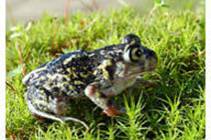
|
Eastern Spadefoot Toad
Scaphiopus holbrookii
Up to 3 inches (72 mm)
Not a true toad. Fairly smooth skin with small warts and vertical cat-like pupils. Short back legs with horny spade-like warts or growths used for digging. Paratoid (shoulder) glands not very visible.
Many people have allergic reactions to touching this amphibian. Underground most of the time. Historically found in our area but may now be extirpated. |
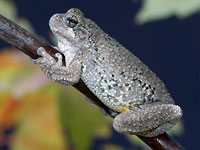
|
Cope's Gray Treefrog
Hyla chrysoscelis
Up to 2.5 inches (62 mm). Usually gray with moist, warty skin. Sticky toe pads. Bright orange or yellow patches concealed under thighs. Light mark under eye. Another Gray Treefrog ( H. versicolor) is almost identical except for its call but is not known to be found in Fairfax or Arlington . 1,000-2,000 eggs are laid in small batches in puddles or shallow bodies of water, attached near the surface. Tadpoles transform in about 2 months. Sometimes incorrectly called ‘tree toads' because of their warty skin, despite their long legs. Can change color with young and adults during breeding season usually being all green. Rarely climb higher than 10 feet. |
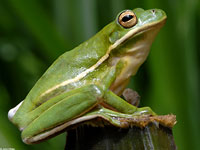
More... |
Green Treefrog
Hyla cinerea
Up to 2.5 inches (64 mm).
Slender green treefrog with long legs, smooth skin, and usually a white ‘racing stripe' along its side. Sticky toe pads.
Tend to stay on vegetation near water. Females lay about 400 eggs on floating vegetation. |
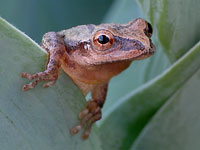
More... |
Northern Spring Peeper
Pseudacris crucifer
Up to 1.5 inches (35 mm).
Tan to gray, often with an X-shaped mark on back and another dark mark between the eyes. Sticky toe pads.
Although treefrogs, they often hide under leaves and tend to use their sticky feet to climb only low shrubs. The smaller males have a dark throat and may be darker than the females.
The high pitched ‘peep' of the males is one of the first harbingers of spring, with them often calling as early as February but peaking around here in early April.
About 900 eggs per female are attached individually or in small groups to objects underwater. Tadpoles transform in 45-90 days. |

More... |
Upland Chorus Frog
Pseudacris feriarum
Up to 1.5 inches (35 mm)
Brown or gray back with a variable pattern but often 3 faint stripes or rows of spots down back. A stripes runs from snout, through the eye and to the groin. Toe pads are very small and so do not climb as well as other treefrogs. The males' call sounds like someone running a fingernail over the teeth of a comb. Females lay about 1000 eggs in batches of 50 or so attached to underwater plants. |
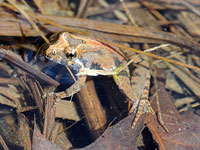
More... |
Northern Cricket Frog
Acris crepitans
Up to 1.5 inches (35 mm)
Moist, warty skin can be quite variable in color. Dark triangular mark between the eyes. Often a Y-shaped mark on back. Male's call sounds like someone is clicking 2 stones together.
Females lay eggs either singly or in small batches, either attached to underwater plants or on the bottom. Tadpoles have black tail tips. |
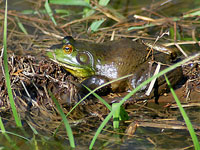
|
American Bullfrog
Lithobates catesbeianus
Our largest frog, up to 8 inches (200 mm)
Olive or brown with blotches (young have more numerous and darker spots). Belly mostly white with mottling. Lack dorsolateral fold but have a thin fold that goes around the tympanum.
Males are smaller, have a larger tympanum (female's is about same size as her eye), and larger thumb/forearm. Males make a deep bass “jug-o-rum” call (both may scream cat-like if caught).
Females lay an egg mass holding about 12,000 eggs (with black top-sides) that hatch in less than a week. The huge tadpoles take 2 (3 up North) years to metamorphose and have a spiracle (breathing hole) on side of head.
Adults will eat anything smaller than themselves, including other bullfrogs. This has caused problems when they have been introduced to areas already containing other amphibians. |
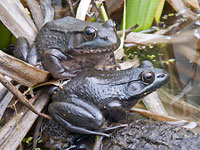
|
Northern Green Frog
Lithobates clamitans
Up to 3.5 inches (86 mm).
Green or brown, sometimes with blotches. Belly is white but may have dark marks on the chest/chin, especially when young. Dorsolateral fold runs to middle of the back.
Males have larger tympanum (larger than eye), yellow throat, and thicker foreleg/thumb. Often give a high pitched ‘squeenk' while jumping if startled. Males give a rubber-band like ‘twang' call in May or June.
Females lay a raft like mass of about 3,000-4,000 eggs that hatch in less than a week. Most tadpoles metamorphose by the end of the first fall but a few may overwinter. |
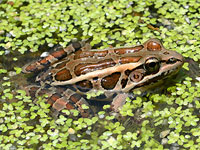
|
Pickerel Frog
Lithobates palustris (Formerly Rana)
Up to 3.5 inches (87 mm).
Has two rows of squarish spots down back and dorsolateral folds. Yellowish thighs and groin. Male's call sounds like a snore and given while floating on or below the water.
Females attach egg masses of about 800-3,000 eggs (brown above, yellow below) to aquatic stems. Tadpole stage lasts from 70-80 days. Adults are said to be distasteful (toxic) to some animals. Even putting them together with other pickerel frogs in collecting bags may result in them poisoning one another.
Prefers living by streams and other clear, cool water sources. |
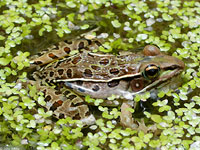
|
Southern Leopard Frog
Lithobates sphenocephalus
Up to 3.5 inches (90 mm).
Large, dark spots irregularly spaced along back. White belly. Dorsolateral folds. Light spot in middle of tympanum distinguishes it from Northern Leopard Frog. No yellow on thighs or groin.
Male's call sounds as though someone is rubbing an inflated balloon and come from 2 vocal pouches, one on each side of the head. The call can be given both above and below the water. Both sexes also give a release call.
Females lay 300-6,500 eggs (black on top, white below) at a time in firm clusters attached to aquatic stems. Older tadpoles have dark spots on tails.
Adults may travel far from water and prefer grassy areas (sometimes feeding near lawn sprinklers and lights). |
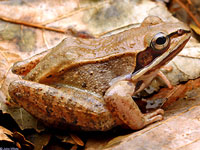
More...
|
Wood Frog
Lithobates sylvaticus
Up to 3.25 inches (83 mm)
Brown frog with dark mask behind the eye. White belly with a dark spot on each side of chest. Dorsolateral folds. Females larger than males.
Extremely cold tolerant (the only American frogs found north of the Arctic Circle). The earliest frogs to breed, usually in February to March.Males give their duck-like “craw-awk” call at vernal pools. Vocal pouches are just above their front legs.
Females lay egg masses of up to 3,000 eggs which may be attached to underwater vegetation and don't hold their shape if removed from the water. Tadpoles usually metamorphose in under 2 months.
May wander far from water in moist woods. |
Frogs and Toads, cont'd...
The distress calls emitted by some species are made with the mouth open and are often higher pitched. Almost all anurans lay their eggs in the water where aquatic larvae emerge (the so-called tadpoles and pollywogs). Metamorphosis starts with the growing of back legs, then the front, and finally the emergence of a miniature anuran with a tail that is soon lost.
Almost all adults are carnivorous while the tadpole stage tends to be herbivores. Adults have stocky bodies with almost no necks (9-10 vertebrae) and 4 legs (devoid of claws in all our native species, with the hind legs usually much longer).
Although not always accepted as actual scientific differences, most differentiate between frogs and true toads. Toads usually have warty skin and short hopping legs as opposed to the long jumping legs and smooth skin of most frogs. Toads also have paratoid glands on the back of their heads which can release a toxin that makes them distasteful to eat. The thicker skin of toads (and some treefrogs) allows them to venture further from the water.
Most frogs have protuberances in their upper jaws called vomerine teeth which toads lack. Some facts to note: One species, the Bornean Flat-headed Frog, does not have any lungs. The world's largest is the 2ft Goliath Frog from Cameroon. Virginia has 27 anuran species of which 13 can potentially be found locally. 2008 has been declared the Year of the Frog. |